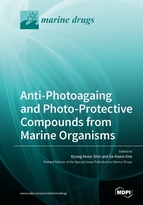Anti-Photoagaing and Photo-Protective Compounds from Marine Organisms
A special issue of Marine Drugs (ISSN 1660-3397).
Deadline for manuscript submissions: closed (30 March 2019) | Viewed by 73623
Special Issue Editors
Interests: marine organic matter; marine biogeochemistry; stable isotope; organic biomarkers; aquatic ecology; marine food web; marine algae; phytoplankton productivity, bioactive compounds; organic geochemistry
Special Issues, Collections and Topics in MDPI journals
Interests: marine natural products; marine biotechnology; marine algae; anti-oxidant; anti-HIV; anti-cancer; anti-allergy; anti-Inflammation; marine cosmeceuticals; nutraceuticals and pharmaceuticals
Special Issues, Collections and Topics in MDPI journals
Special Issue Information
Dear Colleagues,
Human skin is always exposed to ultraviolet radiation, which can cause damage, darken, and wrinkle skin. In recent days, significant development has been achieved in marine derived compounds for their utilization in cosmeceutical development due to their unique and potential uses as cures for various skin-based diseases.
Secondary metabolites, vitamins, carbohydrates, proteins, peptides and enzymes, lipids and phenolic compounds from marine organisms have effectively protected against UV-B-induced damages in skin. These compounds potentially develop as cosmeceuticals in the areas of anti-photoagaing, anti-wrinkle, UV blocking agents, skin whitening, etc.
As Guest Editors of this Special Issue, we cordially invite scientists from around the world to contribute original research articles, long and mini review papers, short notes, and opinions according to their expertise related to "Anti-Photoagaing and Photo-Protective Compounds from Marine Organisms". This Special Issue is aimed at collecting literature on the below-mentioned keyword topics, which can significantly increase our basic understanding of marine-derived compounds in cosmeceutical product development and increases the value of marine products at the industrial level.
Prof. Kyung-Hoon Shin
Prof. Se-Kwon Kim
Guest Editors
Manuscript Submission Information
Manuscripts should be submitted online at www.mdpi.com by registering and logging in to this website. Once you are registered, click here to go to the submission form. Manuscripts can be submitted until the deadline. All submissions that pass pre-check are peer-reviewed. Accepted papers will be published continuously in the journal (as soon as accepted) and will be listed together on the special issue website. Research articles, review articles as well as short communications are invited. For planned papers, a title and short abstract (about 100 words) can be sent to the Editorial Office for announcement on this website.
Submitted manuscripts should not have been published previously, nor be under consideration for publication elsewhere (except conference proceedings papers). All manuscripts are thoroughly refereed through a single-blind peer-review process. A guide for authors and other relevant information for submission of manuscripts is available on the Instructions for Authors page. Marine Drugs is an international peer-reviewed open access monthly journal published by MDPI.
Please visit the Instructions for Authors page before submitting a manuscript. The Article Processing Charge (APC) for publication in this open access journal is 2900 CHF (Swiss Francs). Submitted papers should be well formatted and use good English. Authors may use MDPI's English editing service prior to publication or during author revisions.
Keywords
-
Anti-Oxidative Compounds
-
Anti-Microbial Compounds
-
Anti-Photoagaing Compounds
-
Matrix Metalloproteinases (MMPs) inhibition Compounds
-
UV-Absorbing Compounds
-
DNA protective Compounds
-
Photo-Protective Compounds
- Terpenes
- Carotenoids
- Flavonoids
- Tocopherol
- Retinoid
- Chitin, chitosan and their derivatives
- Carrageenan
- Chondroitin Sulfate
- Fucoidan
- Mycosporine-like amino acid
- Proteins, peptides and Enzymes
- Lipids
- Fatty acids
- Phenolic compounds
-
Marine Cosmeceuticals
-
Marine Pharmaceuticals
-
Industrial Products using Marine Compounds








